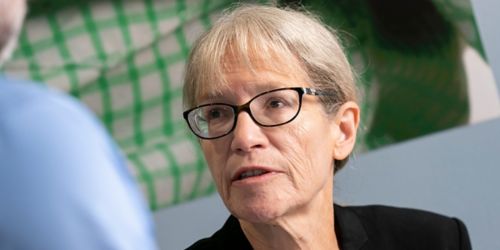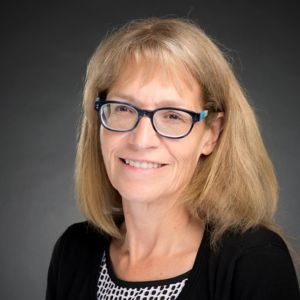St. Jude Family of Websites
Explore our cutting edge research, world-class patient care, career opportunities and more.
St. Jude Children's Research Hospital Home

- Fundraising
St. Jude Family of Websites
Explore our cutting edge research, world-class patient care, career opportunities and more.
St. Jude Children's Research Hospital Home

- Fundraising
Survivorship studies dig in on data

Kirsten Ness, PhD, and her colleagues are following the survivorship data to learn more about the health of childhood cancer survivors.
Childhood cancer may strike early in a person’s life, but the effects of both the disease and its treatment can have an enduring influence. Although doctors have seen these effects in the clinic for many years, to really understand the challenges childhood cancer survivors face we need to conduct scientific research – we need data.
That is where the St. Jude Lifetime Cohort Study (St. Jude LIFE) and the Childhood Cancer Survivor Study (CCSS) come in. Both efforts have created resources for research by systematically collecting data on the health of childhood cancer survivors.
Through St. Jude LIFE, long-term childhood cancer survivors come back to St. Jude for regular health screenings throughout their adult lives. To date, more than 5,000 participants and 580 control subjects have undergone comprehensive health evaluations through St. Jude LIFE. The study tracks a wide range of health outcomes, using measures of cardiac, reproductive, neuromuscular, neurocognitive and psychosocial function, among others.
The CCSS is a retrospective cohort of nearly 36,000 childhood cancer survivors and 5,000 siblings of survivors. The CCSS comprises 35 participating centers in the U.S. and Canada. It is coordinated through St. Jude and supported by the National Cancer Institute and National Institutes of Health.
With these resources, my colleagues and I are able to follow the data to learn more about the health of childhood cancer survivors. Our recent published work shows that with increased understanding we can continue to optimize treatments and improve care throughout the lives of survivors.
Can where a survivor lives influence obesity?
Where you live matters when it comes to health. This is called the neighborhood effect, and it reflects the characteristics of the neighborhood where someone lives and how that influences their health. Our team recently used data from St. Jude LIFE to look at the neighborhood effect on obesity in childhood cancer survivors. This included socioeconomic status, access to healthy food and availability of safe places to exercise.
The results are striking and indicate that where a survivor lives is associated with obesity. Thus, interventions for obesity in survivors should include strategies that take into account where they get their groceries and whether or not they have safe places to exercise.
“A better understanding of how neighborhood influences obesity in childhood cancer survivors can help us guide future obesity interventions,” said first author Carrie Howell, PhD, Epidemiology and Cancer Control.
A paper detailing this work was published in the International Journal of Cancer.
Exercise intolerance linked to heart failure and mortality
While many children with cancer can be cured with modern therapies, treatment can affect heart health. Using data from St. Jude LIFE, we studied the relationship between treatments that impact the heart and exercise intolerance (inability or decreased ability to perform physical exercise) in childhood cancer survivors.
“Our results showed that survivors in their 30s had exercise intolerance at rates similar to rates in the general population of individuals in their 60s and 70s,” said senior author Greg Armstrong, MD, of Epidemiology and Cancer Control.
The reduced exercise tolerance was associated with increased risk for mortality. Understanding how exercise is affected by cancer treatments is important for guiding the care of survivors.
Fortunately, exercise intolerance can be improved with exercise, even in persons with chronic disease.
This work was published in the Journal of Clinical Oncology.
Frailty among childhood cancer survivors compared to their siblings
Low energy expenditure, exhaustion, walking limitations, weakness and low lean muscle mass are what constitute frailty in older adults. Using data from the CCSS we looked at the prevalence and predictors of frailty among childhood cancer survivors of at least five years, compared with siblings who did not have cancer.
We found that childhood cancer survivors are three times more likely than siblings to have frailty. Survivors in their 30s had frailty rates similar to older adults. In particular, survivors exposed to certain types of radiation and lung surgery treatments had an increased risk of developing frailty.
“Interventions to prevent, delay, or address chronic disease and promote healthy lifestyles are needed to decrease the prevalence of frailty and preserve function among childhood cancer survivors,” said first author Samah Hayek, PhD, of Epidemiology and Cancer Control.
The Journal of Clinical Oncology published a report on this work.
Exercise may give the brain a boost
Childhood cancer survivors are more likely to have limited ability to exercise. Yet, physical activity can have a positive effect on cognitive ability.
We led a study to better understand the relationship between exercise and cognitive ability using data gathered through St. Jude LIFE. We tested 341 childhood leukemia survivors and 288 control subjects and found that improving cancer survivors’ physical fitness may boost their thinking and learning skills.
“Even minor changes like going from sitting to walking for 30 minutes can have an effect,” explained first author Nicholas Phillips, MD, PhD, of Epidemiology and Cancer Control.
This work appeared in the journal Cancer.






